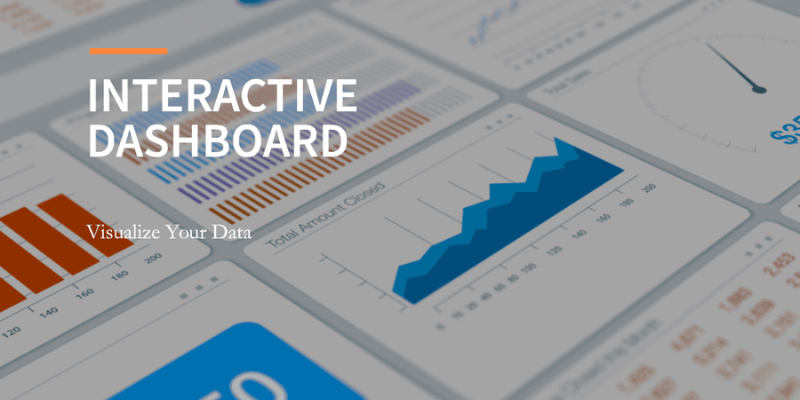In today’s data-driven world, businesses, analysts, and decision-makers rely heavily on interactive dashboards to present and interpret data effectively. Interactive dashboards, as opposed to static reports, let users select results, study data interactively, and obtain insightful information instantly. A well-designed dashboard not only enhances data visualization but also improves decision-making processes by providing actionable insights at a glance.
This blog explores the key steps, tools, and best practices involved in creating interactive dashboards for data presentation.
1. Define the Purpose and Audience
Before designing a dashboard, it is crucial to understand its purpose and target audience. Ask yourself the following questions:
- What insights should the dashboard provide?
- Who will use it (executives, analysts, sales teams, etc.)?
- What key metrics and KPIs need to be displayed?
Clearly defining these factors ensures that the dashboard is relevant, user-friendly, and aligned with business goals. A Data Science Course in Trivandrum can help you understand how to align dashboards with business objectives effectively.
2. Select the Right Data Sources
Interactive dashboards rely on accurate and up-to-date data. IDetermine and incorporate pertinent data sources, including:
- Databases (SQL, NoSQL, etc.)
- Spreadsheets (Excel, Google Sheets)
- Cloud storage solutions
- APIs from business applications (CRM, ERP, etc.)
Data cleaning and preprocessing are essential to remove inconsistencies and ensure seamless integration with the dashboard.
3. Choose the Right Dashboard Tool
Various tools are available for creating interactive dashboards, each with unique features. Some of the most popular dashboard tools include:
- Power BI: Microsoft’s robust tool for business intelligence and data visualization.
- Tableau: A powerful analytics platform for creating dynamic dashboards.
- Google Data Studio: A simple and free tool for incorporating data sources from Google.
- Looker: A cloud-based platform that supports deep data exploration.
- Excel and VBA: Suitable for small-scale interactive dashboards.
The choice of tool depends on data complexity, user requirements, and integration needs. A Data Science Course in Jaipur can provide hands-on experience in working with these tools.
4. Design an Intuitive Layout
A well-structured dashboard improves usability and engagement. Follow these design principles:
- Keep it simple: Avoid clutter and focus on key metrics.
- Use a logical flow: Arrange data in a way that tells a compelling story.
- Ensure consistency: Use uniform colors, fonts, and design elements.
- Optimize for responsiveness: Ensure the dashboard works well on different devices.
5. Implement Interactive Features
Interactive elements enhance user engagement and allow deeper data exploration. Key features include:
- Filters and Drop-downs: Enable users to select data based on categories, time frames, or locations.
- Drill-downs: Allow users to click on a data point to view more detailed information.
- Hover-over Tooltips: Display additional insights when users hover over charts.
- Dynamic Charts and Graphs: Enable real-time updates based on selected inputs.
- Search Functionality: Provide search functionality so that consumers may easily find certain data points.
A Data Science Course in Trichy can help you master advanced interactive dashboard features and their applications.
6. Connect and Automate Data Updates
Interactive dashboards should display real-time or periodically updated data. Automate data updates by:
- Scheduling data refreshes in tools like Power BI or Tableau.
- Connecting to live databases via APIs.
- Using cloud-based data connectors for automatic synchronization.
This ensures that the dashboard remains accurate and up to date without manual intervention.
Read more: Data Wrangling Techniques Every Data Scientist Should Master
7. Optimize Performance
Performance optimization is critical for dashboards handling large datasets. Strategies include:
- Aggregating Data: Summarize data instead of displaying raw records.
- Using Indexing and Caching: Speed up data retrieval.
- Optimizing Queries: Use efficient database queries to minimize loading times.
- Reducing Unnecessary Visuals: Avoid excessive animations and graphics that slow down performance.
8. Test and Gather Feedback
Before deployment, thoroughly test the dashboard for:
- Functionality: Ensure all interactive elements work correctly.
- Accuracy: Verify that data is correctly displayed.
- Usability: Test with actual users to identify potential improvements.
- Compatibility: Check responsiveness across devices and browsers.
To increase the dashboard’s efficacy, get input from stakeholders and make the required changes. If you want hands-on experience in testing data dashboards, a Data Science Course in Delhi is a great option.
9. Deploy and Maintain the Dashboard
Once the dashboard is finalized, deploy it on a secure platform accessible to intended users. Maintenance is essential to keep the dashboard relevant and operational. Regularly update:
- Data sources and connections
- Visual elements for clarity and usability
- Security settings to protect sensitive information
Monitoring user interactions can also help identify areas for improvement.
Interactive dashboards are essential for data-driven decision-making, offering a dynamic and user-friendly way to present insights. By defining the purpose, choosing the right tools, designing an intuitive layout, incorporating interactive features, and ensuring performance optimization, businesses can create impactful dashboards that enhance data visualization and analysis.
Whether for business intelligence, financial reporting, or performance tracking, Raw data is transformed into insightful knowledge by a well-designed interactive dashboard, enabling users to make wise choices.
Also Check: What Role Does Machine Learning Play in Data Science?

